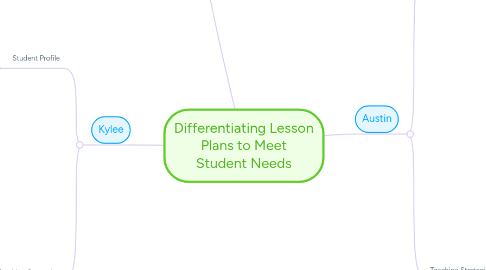
1. Objective
1.1. 5th Grade Math
1.2. SWBAT demonstrate the process of subtracting fractions with unlike denominators using equivalent fractions with at least 85% accuracy.
2. Kylee
2.1. Student Profile
2.1.1. Learning Profile
2.1.1.1. Highly intelligent
2.1.1.2. Extremely shy
2.1.1.3. Often finished assignments early and is bored easily.
2.1.2. Interests
2.1.2.1. Playing a variety of musical instruments
2.1.2.2. Reading
2.1.2.3. Painting
2.1.2.4. Computers
2.1.3. Readiness levels
2.1.3.1. She excels and performs 110% on her work.
2.1.3.2. She is very proficient in adding/subtracting fractions.
2.1.3.3. She feels comfortable working with partners, but feels stressed when working in groups of 3 or more.
2.1.3.4. She panics when teachers call on her in class.
2.2. Teaching Strategies
2.2.1. Allow the student to work with a partner that she is comfortable with, even if other students are working in groups.
2.2.2. When she finishes with assignments/work early, provide computer time.
2.2.3. Avoid calling on the student in class whenever possible.
2.2.4. Provide additional challenge problems on work to help develop higher level thinking skills and challenge the student, so that she is not bored.
3. Austin
3.1. Student Profile
3.1.1. Learning Profile
3.1.1.1. Diagnosed with ADHD, very active, causes frequent class disruptions.
3.1.1.2. Enjoys math activities on the computer.
3.1.1.3. He has a poor attitude toward school and feels restricted in the classroom.
3.1.2. Interests
3.1.2.1. Cars
3.1.2.2. Football
3.1.2.3. Video games
3.1.3. Readiness levels
3.1.3.1. He is very intelligent and is working at grade level in math.
3.1.3.2. Does well with number problems, but has difficulty with word problems.
3.1.3.3. He performs well when working in with a partner or in small groups.
3.1.3.4. Does not complete homework on a regular basis.
3.1.3.5. He has proclaimed that he HATES fractions.
3.2. Teaching Strategies
3.2.1. Break down assignments into smaller, less complex tasks. For example, allowing student to complete a five math problems before giving the remaining five problems.
3.2.2. Eliminate timed test in order to reduce test anxiety.
3.2.3. Provide a partner for math activities to help maintain the student's focus.
3.2.4. Use the smart board to help student visually grasp concepts.
3.2.5. Schedule time for computer games in order to practice mathematical concepts each week.
3.2.6. Teach the student to read word problems a minimum of two times before beginning to solve a problem.
3.2.7. Teach the student to ask guiding questions in solving word problems, in order to understand what is being asked for in the question.
3.2.8. Frequently provide hands-on project based learning activities to allow student to move around and work with others.
3.2.9. Involve parents in making sure homework is completed daily.

